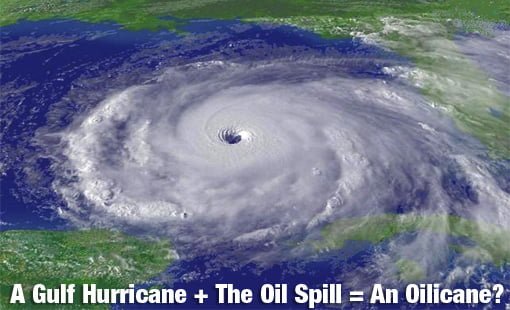
TRUMP SAYS: HUNTER MAKES FORTUNE FROM SHADY DEALS!
BIDEN FAMILY STINKS TO HIGH HEAVENS OF CORRUPTION!
DON'T GET LEFT OUT: HUNTER MUST BE STOPPED!
This article has been generously contributed by OilPrice.com.
By. Art Horn

The gulf oil spill is bad but it could become much, much worse and soon. The threat is a hurricane moving over the spill. If a hurricane’s violent winds track over the spill, we could witness a natural and economic calamity that history has never recorded anywhere or anytime. We will literally be in oil-soaked waters. We will have witnessed the first oilicane.
A category one hurricane (on a scale of 1 to 5) has maximum sustained winds of 74 to 95 miles per hour near the eye. A category five hurricane has maximum sustained winds of 156 to 200 miles per hour. The difference between the two storms is gigantic and non-linear. The latter hurricane may cause 250 times more damage than the former.
Water temperatures in the Atlantic Ocean are now running as warm or warmer than they did during the record setting season of 2005. This is significant. Warmer water means more heat and humidity over the tropical ocean to fuel hurricanes. Just as a car needs gasoline to fuel its engine, a hurricane needs hot, humid air because a hurricane is little more than a gigantic atmospheric engine. The warmer and more humid the air it breaths in, the faster its pistons pump and the stronger its winds become. The warmer water not only makes more hurricanes, it make more big ones. The 2005 season had a record 15 hurricanes. Nobody knows how many there will be this season. But it appears that it could be a big year.
Oil continues to gush out of the bottom of the gulf. Some progress has been made to reduce the amount escaping. Oil is washing up on shores and efforts are being made to clean it up. The good news is that most of the oil is confined to coastal areas. The bad news could come if a moderate to large hurricane rides over the spill.
The winds of a hurricane are so strong that the normal interface between ocean and atmosphere disappears. The winds begin to generate large waves. Spray is blown off the top of the waves. That spray mixes with the air so that after a short time there is no real boundary between what is ocean and what is the atmosphere. If a large hurricane moves over the spill, this chaotic mixture of water and air will inevitably also contain oil. The oil will become airborne and travel with the hurricane.
When hurricanes make landfall the winds push the ocean onto the land in what is called a storm surge. The height of the surge on land is dependent on several factors. The strength of the wind and the rate of forward motion of the storm is critical as to how much water is forced up onto the land. The diameter of the hurricane will also determine how much water is blown inland. The wider the storm the more water is pushed in and over a greater area. If the water is shallow offshore, the surge will be deeper on land. Naturally, the elevation of the land is important as well. The water off the gulf coast is shallow. The elevation inland is only a few feet. This area is prime territory for devastating and deeply penetrating storm surges.
Should a major hurricane push the spill towards the gulf coast there will be nothing that can be done to stop it. No amount of planning or engineering will help. No number of visits to the gulf by the president or any other official will stop the inevitable. The storm surge will drive the water and the oil miles inland. Everything in its path will be coated in a greasy bath of crude. Even the wind may have oil in it. In New England, I have seen hurricanes and tropical storms that have blown salt spray many miles inland from the coast. The leaves of the trees eventually turn brown and fall off. In the case of the gulf it will be oil that will spray the trees, buildings and everything else in the way. How far inland this oily mess will blow is anyone’s guess but it will be unprecedented in its economic and environmental damage.
The recovery period after a hurricane can take years. It was 10 years until some communities fully recovered from Hurricane Andrew in South Florida, some never recovered at all. The New Orleans area is still putting itself back together after Katrina in 2005. The recovery period after an oil-soaked hurricane — or what could be called an Oilicane – is impossible to forecast but it could take years and many billions of dollars. One wonders if BP has the money to survive such a unique disaster. The human and natural losses from such an event could be historic.
By. Art Horn
This article has been generously contributed by OilPrice.com and was originally published at the Energy Tribune.
Related Reading:
Oil Hurricanes May Cause Toxic Rain and Food Security Issues
Oil Rain Killing Crops, Animals – What Will It Do To Humans?

It Took 22 Years to Get to This Point
The United Kingdom could suspend the United States pharmaceutical company Moderna over its shady...
This article was originally published by Tyler Durden at ZeroHedge. President Donald Trump...
Bird flu has been detected in mammals on the Texas panhandle, including skunks, raccoons, and...
The advancement of artificial intelligence is a "necessary evil" to some and a hindrance to...
Commenting Policy:
Some comments on this web site are automatically moderated through our Spam protection systems. Please be patient if your comment isn’t immediately available. We’re not trying to censor you, the system just wants to make sure you’re not a robot posting random spam.
This website thrives because of its community. While we support lively debates and understand that people get excited, frustrated or angry at times, we ask that the conversation remain civil. Racism, to include any religious affiliation, will not be tolerated on this site, including the disparagement of people in the comments section.


This whole thing is a fucking disaster. Â Hope everyone has seen what they want to of the Gulf, because it will never be clean in our lifetimes again. Â Prince William Sound in Alaska is still full of oil to this day. Â Exxon got out of paying much of anything, and in spite of appearances, it’s likely that BP will successfully dodge their responsibility too. Â This is the new “capitalism” that has been pushed on us in the last 30 years. Â Corporate personhood and total lack of concern for anything but profits are the hallmarks of this new business model. Â This is the result of years of “getting government off our backs”. Â We went from marginally effective regulation, to no regulation whatsoever, and now we have “regulations” that are actually written by the people who are supposed to be regulated. Â We are getting what we voted for all those years.
Florida is totally screwed if an oilcane visits the state’s citrus groves.
Crop failures and property damage alone from a hurricane filled with oil could be too catastrophic for the insurance industry to bear. And the lawsuits and claims filed against BP would put them out of business for good.
A lot of people are in denial and refuse the possibility that things could get worse.Mac, if what you are describing becomes a reality, the Southeastern United States could become a proverbial wasteland as millions of survivors pack up and move North.Entire regions of the Gulf would see mandatory evacuations because oil contamination,combined with the hurricane devastation, would make these areas unsafe for human existence. I read articles when this oil spill first occurred where scientist were suggesting a worst case scenario could make this an extinction-level-event.
It’s difficult to imagine what would happen next. I would not be surprised to see BP gas stations burn to the ground as people filled with rage look for someone to blame. My motto has been  ‘hope for the best while preparing for the worse’. Now, I have to consider evacuating my home with the possibility of ‘never’ being able to return. A Get-Out-Of-Dodge plan with a Bug-Out-Vehicle big enough to live in will have to move to the top of my planning list. Wow, this really puts a wrench in my prepping strategies.
Thanks for the ‘Wake Up Call’Â Mac.
Wheedle, let’s hope that this article and the ones we presented, along with all the scientists doing work on this, are wrong.
The other possibility is that a massive hurricane(s) will churn the oil and dispersant enough to not cause oil-related damage along the coast and into the mainland.
Though, I am going to have to think worst-case here, because I definitely don’t want to end up wading through oil soaked flood waters down here in Houston. It’s bad enough when the power goes out, the water gets turned off, there’s no fuel and no food readily available for days, or in the most recent Hurricane Ike case, for weeks. On top of that, we would add toxic fumes and poisoned flood waters. Bad news.
I planned on hunkering down and going prepper during the hurricane season this year with Cat-4 or under, but now our plan is to just go ahead and bug-out for any level hurricane – just in case.
We have somewhere to go, but there are millions of people (example: Hurricane Katrina Superdome debacle) that have nowhere to go, or even a means of transport to get them out of the way.
My view is, that any hurricane that manifests will be treated as a National Emergency – it has to be. The government really doesn’t know what can happen here, especially with this much oil and toxic fumes. So, they will likely also go worst-case, which means we’re looking at mass evacuations along the target areas.
This will require deployment of the National Guard and FEMA.
Those FEMA camps that Glen Beck says are non-existent will become evident to all Americans. Beck debunked FEMA “concentration camps,” but there actually are facilities ready for national emergencies, and if we see mass evacuations, this is where those without a place to go will end up.
Martial law will be declared, maybe not officially, but FEMA will take control of all aspects of evacuation.
This means that all Presidential Executive Orders will go into effect, which means everything from weapons, to vehicles to food can be seized during evacuations. Under the EO’s, the populace will be required to follow all orders given them by officials.
We plan on getting out of Dodge at the first sign of an Oilcane headed our way to avoid the chaos…
Easier said than done, I’m sure.
So what do you guys all think will happen with an “oilcane”? Â I don’t live in the south, but don’t these storms usually travel far inland, up the eastern seaboard or into LA/TX a good ways? Â What happens if one of these things heads up into the food producing areas (beef in TX, or crops elsewhere)? Â The stockyards in TX would be an oily mess, and no one would want to eat that…….
@ Jonny V
I believe the aftermath of a storm will leave oil soaked soil & buildings cooking in the hot sun. The fumes could become so toxic that people, livestock, wildlife,,, will have trouble breathing.That will be the most obvious threat to consider.
The aftermath of a oil storm could cause that nationwide panic many of us have pondered, as people begin to hoard food, bottled water,,,thinking shortages will occur thus causing shortages.
Oil hurricanes would be ‘bad on top of bad’ for the whole country IMHO.
Â
The toxic fumes and contaminated water sources are an eye opener for me. This is a game changer in prepping.
I didn’t have an oil/water separator on my list either………
Where all all those people going to go? will 40 million fit in those FEMA camps? Best to move now if along the coast and rent a u haul or other means to move. Leave stuff that is useless, or toss it in the dumpster/give away. Most have tons of useless stuff. I’ m 80 mi inland from Fla. and have recently given away/sold off “stuff” I don’t have a use for.  My area may not have to evac. and many will stay put and defend a paid for house, biz, etc. Civil war will break out. What a freakin’ nightmare. I’m glad I never raised a family.
This is one of those areas that no one knows for sure what will happen.  Worst case as described by many is certainly a possibility,  however,  lets hope for the best case…. a hurricane could totally clean up the spill  and dump it on Mexico or Venezuela.
This is new territory. Man never should never have drilled at a depth where the PSI exceeds the ability of our technology to control. That’s moot now.
Best case, coastlands are destroyed for at least a generation. The tidal surge from a hurricane would move oil far inland in those low-lying areas. People and businesses are ruined; species are extinct; our already fatally wounded economy takes another serious blow, shortening it’s already short lifespan.
Worst case - TEOTWAWKI. I never expected this as a catalyst though… This is probably a good time to invest in some active carbon water filtration. It will remove VOCs from water (there are other methods as well). I have a growing concern about water system contamination, if this plays out badly.
I expect my area of Texas will become more crowded as hurricane activity picks up. It did during Katrina.
@Jonny V – I’ll try to take some pictures of cattle slipping on and covered in oil, if it comes to that. Those beasts are less than graceful to begin with. That should be interesting…
Hey Sartx, maybe if all the cows die from the poison rain, we’ll be eating buffalo again. Â They sell it in my area and it’s really good. Â I now actually prefer buffalo to beef, (based on taste). Â And you’re right, cows aren’t graceful.
Jonny V – Damn cattle are too dumb to die from oil rain. They do have to eat though and their food source could be destroyed; and they could be poisoned from VOCs in water. I’ve eaten buffalo; even had beefalo, when they tried that cross-breeding. Only in the hamburger form though. I’ve never had a buffalo steak.
Speaking of buffalo, ever think of post-ammunition and investing in a good bow / crossbow system?
Sorry, I’m geting off-topic…
Buffalo and beefalo are really good. Â Find a Whole Foods in your area and get a buffalo ribeye, Â it’s really good. Â Cook time is much faster so watch out. Â Fat content is lower than white meat chicken. Â As far as ammo goes, buffalo will just stand there and let you walk right up and shoot them. Â Just get a Marlin in 45/70 and you’re in. Â Not to mention, you can get some real hard-core loads for this round, bordering on 458 magnum territory. Â The 45/70 should be on anyone’s short list of SHTF guns……..
I found this on  the N.O.A.A page.
http://www.noaa.gov/factsheets/new%20version/hurricanes_oil.pdf